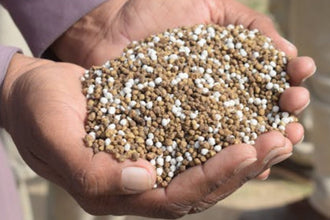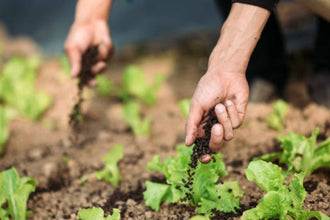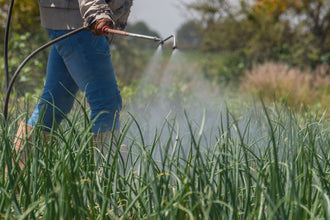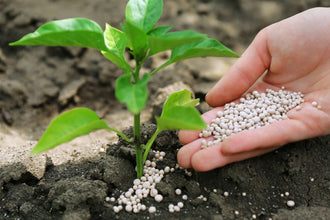
NPK fertilizer is what keeps most gardens growing strong and healthy. Those three letters stand for nitrogen (N), phosphorus (P), and potassium (K). These are the nutrients your plants crave most. Whether you're growing tomatoes in your backyard or managing acres of crops, understanding NPK fertilizer makes all the difference.
You've probably seen those three numbers on fertilizer bags. Something like 10-5-5 or 20-20-20. The first number tells you how much nitrogen is in there. The second shows phosphorus. The third is potassium. Once you know what these numbers mean, picking the right fertilizer gets much easier.
Plants are pretty simple when you think about it. They need food just like we do. Sure, they make their own energy from sunlight, but they still need nutrients from the soil to grow properly. That's where NPK fertilizer comes in.
What Each Nutrient in NPK Fertilizer Does for Your Plants
Your plants need seventeen different nutrients to grow their best. But nitrogen, phosphorus, and potassium are the big three. Most soils have some of these nutrients naturally, but usually not enough for the kind of results gardeners want.
Nitrogen is what makes plants green and leafy. Without enough nitrogen, your plants look pale and grow slowly. Phosphorus helps roots grow strong and gets flowers and fruit going. Potassium keeps plants healthy and helps them fight off diseases and handle bad weather.
How Nitrogen Helps Your Garden
Nitrogen does a lot of heavy lifting in your garden. Plants use it to make chlorophyll, which is that green stuff that captures sunlight. They also need nitrogen to build proteins and run all their internal processes.
When plants don't get enough nitrogen, they tell you right away. The leaves turn yellow, starting with the older ones at the bottom. Growth slows down. Your vegetables stay small. Your flowers look sad. Adding nitrogen-rich NPK fertilizer usually fixes these problems fast.
But here's the thing about nitrogen. Plants can't store it for long. They use it up quickly, especially when they're growing fast in spring and summer. That's why most gardens need regular applications of NPK fertilizer throughout the growing season.
What Phosphorus Does for Plant Growth
Phosphorus works behind the scenes in ways you might not notice at first. This nutrient helps plants store and move energy around. Seeds need phosphorus to germinate properly. Roots use it to grow deep and strong. Flowers need it to develop into fruit.
You'll know if your plants aren't getting enough phosphorus. The leaves might turn purple or dark green. Flowering gets delayed or just doesn't happen. Root vegetables stay small. Fruit trees produce less. NPK fertilizer with good phosphorus levels solves these issues.
Most soils hold onto phosphorus pretty well once it's there. That means you don't need to apply it as often as nitrogen. But new gardens and container plants usually need regular phosphorus feeding through NPK fertilizer applications.
Why Potassium Matters More Than You Think
Potassium is like vitamins for plants. It doesn't directly make them grow bigger, but it keeps them healthy and strong. Plants use potassium to control water movement and activate enzymes they need for photosynthesis.
Plants with enough potassium handle stress better. They resist diseases more effectively. They survive droughts and cold snaps that would damage other plants. Their fruit tastes better and stores longer. Quality NPK fertilizer provides the potassium plants need for these benefits.
Potassium deficiency shows up as brown edges on leaves. Plants look weak and get sick easily. Fruit quality drops. Cold weather damages them more than it should. Adding NPK fertilizer with adequate potassium levels prevents these problems.
Choosing the Right NPK Fertilizer for Different Plants
Not every plant needs the same nutrition. Leafy vegetables like lettuce and spinach love nitrogen. Flowering plants need extra phosphorus. Root vegetables benefit from balanced nutrition with good potassium levels. Understanding these differences helps you pick the right NPK fertilizer for each part of your garden.
Organic NPK fertilizers work differently than synthetic ones. They release nutrients slowly as soil bacteria break them down. This matches how plants naturally feed and reduces the chance of burning roots. Synthetic fertilizers work faster but need more careful handling.
Best NPK Fertilizer Ratios for Vegetables
Most vegetable gardens do well with balanced NPK fertilizer ratios. Something like 10-10-10 works great for general use. But different vegetables have different needs at various growth stages.
Here's what works well for common vegetables:
• Tomatoes and peppers: Start with balanced NPK fertilizer, switch to higher phosphorus when flowering begins • Leafy greens: Higher nitrogen ratios like 15-5-5 keep leaves growing and green
• Root vegetables: Balanced nutrition with extra potassium for better storage and flavor • Beans and peas: Lower nitrogen since these plants make their own, focus on phosphorus and potassium • Corn and squash: Heavy feeders that need regular applications of balanced NPK fertilizer
NPK Fertilizer for Flowers and Ornamentals
Flowering plants have specific needs that change with the seasons. Young plants establishing roots need balanced NPK fertilizer. Once they're growing well, they usually prefer formulas with more phosphorus to promote blooming.
Annual flowers that bloom all season need regular feeding. Perennials often do fine with spring and fall applications. Bulbs benefit from phosphorus-rich NPK fertilizer applied when planting and again as shoots emerge.
Container plants need more frequent feeding than ground plants. The regular watering washes nutrients away faster. Use diluted NPK fertilizer more often rather than strong applications that might burn roots.
Lawn Care with NPK Fertilizer
Grass needs steady nutrition to stay thick and green. Most lawns do best with higher nitrogen NPK fertilizer ratios. Cool season grasses like fescue and bluegrass need spring and fall feeding. Warm season grasses like bermuda prefer summer applications.
The key with lawn NPK fertilizer is consistency. Light, regular applications work better than heavy, infrequent ones. Too much at once can burn grass or cause excessive growth that needs constant mowing.

When and How to Apply NPK Fertilizer
Timing makes a huge difference with NPK fertilizer applications. Plants can't use nutrients when they're dormant. Cold soil prevents root uptake even if plants are trying to grow. Understanding seasonal patterns helps you get the most from your fertilizer.
Most plants need their heaviest feeding during active growth periods. Spring applications get things started after winter dormancy. Summer feeding maintains growth during peak season. Fall applications help plants prepare for winter.
Spring NPK Fertilizer Applications
Spring is when most plants wake up and start growing again. This is prime time for NPK fertilizer applications. But timing matters. Applying too early when soil is still cold wastes fertilizer and money.
Wait until soil temperatures reach at least 50 degrees before major applications. Plants can't absorb nutrients from frozen or very cold soil. In most areas, this happens 2-4 weeks before the last expected frost.
Start with balanced NPK fertilizer for most plants. Focus on nitrogen to promote new growth after winter. Work granular fertilizer into the top few inches of soil around plants. Water thoroughly after application to move nutrients down to root level.
Summer NPK Fertilizer Maintenance
Plants work hardest during summer heat. They need steady nutrition to handle stress and keep producing. But hot weather changes how you should apply NPK fertilizer.
Apply fertilizer early morning or evening when temperatures are cooler. Hot sun can burn leaves if fertilizer sits on them. Water plants well before and after fertilizer applications. Stressed, dry plants can't handle sudden nutrient loads.
Liquid NPK fertilizer works great for quick summer feeding. Mix according to directions and apply during cooler parts of the day. This gives plants immediate nutrition without shocking their systems.
Fall NPK Fertilizer Strategy
Fall feeding helps plants prepare for winter. But the approach changes from spring and summer applications. You want to strengthen plants without encouraging tender new growth that freezes easily.
Reduce nitrogen levels in fall NPK fertilizer applications. Focus more on phosphorus for root strength and potassium for cold tolerance. This helps plants store energy for winter survival and quick spring recovery.
Apply fall NPK fertilizer 6-8 weeks before expected hard frost. This gives plants time to absorb nutrients and prepare for dormancy. Later applications might encourage growth that doesn't have time to harden off before winter.
Avoiding Common NPK Fertilizer Mistakes
Most gardening problems come from too much fertilizer rather than too little. Plants are pretty good at making do with less nutrition, but they struggle when overfed. Understanding proper application prevents expensive mistakes and plant damage.
Over-fertilizing creates weak, disease prone growth. Too much nitrogen delays flowering and fruiting. Excess phosphorus can tie up other nutrients plants need. Heavy applications can burn roots and kill plants outright.
Reading Your Plants' Nutrient Needs
Plants tell you what they need if you know how to look. Pale, slow growing plants usually need more nitrogen. Purple leaves often signal phosphorus deficiency. Brown leaf edges suggest potassium problems.
But don't assume every problem comes from lack of NPK fertilizer. Overwatering, poor drainage, and pest damage cause similar symptoms. Check soil moisture and look for insects before adding more fertilizer.
Soil testing takes the guesswork out of NPK fertilizer decisions. Most extension services offer affordable tests that show current nutrient levels. Test every 2-3 years to track soil improvements and adjust your fertilizer program.
Application Best Practices
Never apply NPK fertilizer to dry soil or drought stressed plants. Water first, then fertilize, then water again. This prevents root burn and helps nutrients move into the root zone where plants can use them.
Granular fertilizers need to be watered in within 24 hours of application. Rain works fine if it's coming soon. Otherwise, run the sprinklers or get out the hose. Fertilizer sitting on top of dry soil doesn't help plants and might burn them when it finally gets wet.
Follow package directions for application rates. More isn't better with NPK fertilizer. Plants can only absorb so much at once. Excess fertilizer washes away and pollutes groundwater or runs off into streams and lakes.
Building Healthy Soil with NPK Fertilizer
Good soil makes NPK fertilizer work better. Healthy soil contains millions of beneficial bacteria and fungi that help plants absorb nutrients. These tiny helpers break down organic matter and protect roots from harmful organisms.
Chemical fertilizers can disrupt soil life when used exclusively. Combining synthetic NPK fertilizer with organic matter keeps soil biology healthy while providing immediate plant nutrition. Compost, aged manure, and organic fertilizers feed both plants and soil organisms.
Soil pH affects how well plants can use NPK fertilizer. Most vegetables and flowers prefer slightly acidic to neutral soil between 6.0 and 7.0 pH. Very acidic or alkaline soils tie up nutrients even when fertilizer levels are adequate.
Why Fancy Chicken Organic NPK Fertilizer Works Better for Your Garden
The Natural 4-2.5-2 NPK Formula That Feeds Soil First
Fancy Chicken organic fertilizer delivers a carefully balanced 4-2.5-2 NPK ratio that works differently than synthetic options. This pelletized chicken manure doesn't just feed your plants - it feeds the soil biology that keeps gardens thriving year after year.
The moderate nitrogen level prevents the excessive leaf growth that weakens plants and attracts pests. The phosphorus content supports strong root development and reliable flowering without creating nutrient lockouts. The potassium levels help plants resist diseases and handle weather stress naturally.
Most importantly, Fancy Chicken NPK fertilizer releases nutrients slowly as soil microbes break down the organic matter. This matches how plants naturally feed and prevents the nutrient spikes that can burn roots or create imbalanced growth.
How Organic NPK Differs from Chemical Fertilizers
Chemical fertilizers flood plants with immediately available nutrients. This creates quick growth spurts followed by nutrient crashes that stress plants. Fancy Chicken's organic approach provides steady nutrition that lasts months instead of weeks.
The organic matter in Fancy Chicken fertilizer improves soil structure as it breaks down. Clay soils drain better and sandy soils hold water longer. This creates the ideal growing environment that synthetic NPK fertilizer can't provide.
Here's what makes Fancy Chicken NPK fertilizer work better long-term:
-
Feeds beneficial soil bacteria and fungi that protect plant roots
-
Improves soil structure and water-holding capacity over time
-
Releases nutrients slowly to match plant uptake patterns
-
Won't burn plants even with generous applications
-
Builds soil organic matter that stores nutrients between applications
Application Timing for Maximum Results
Fancy Chicken NPK fertilizer works best when applied at the beginning of growing seasons. The slow-release nature means one application often lasts 6-8 weeks, reducing the need for constant refeeding.
Spring applications give plants steady nutrition through their most active growth period. The organic matter continues breaking down through summer, providing nutrients when plants need them most. Fall applications help build soil reserves for strong spring emergence.
Container gardens benefit from lighter, more frequent applications since watering washes nutrients away faster. Mix Fancy Chicken pellets into potting soil or apply as top dressing every 4-6 weeks during growing season.
Perfect Plants for Organic NPK Fertilizer
The balanced 4-2.5-2 ratio in Fancy Chicken fertilizer works well for most garden plants. Vegetables respond with stronger growth and better disease resistance. Flowering plants produce more blooms that last longer. Lawns develop deeper root systems that handle drought stress better.
Organic gardeners especially appreciate how Fancy Chicken NPK fertilizer supports beneficial insects and soil organisms. The slow nutrient release prevents the rapid growth flushes that attract aphids and other pest insects.
Your Garden Deserves Better Than Quick Fixes
Chemical fertilizers promise fast results but leave your soil depleted and dependent on constant feeding. Fancy Chicken organic NPK fertilizer takes a different approach - building soil health that supports plants naturally while providing the nutrition they need to thrive.
Every application of Fancy Chicken fertilizer makes your soil richer and more alive. The beneficial microbes multiply. The soil structure improves. Your plants grow stronger and more resilient with each growing season. Stop feeding just your plants and start feeding your soil. Your garden will reward you with healthier growth, better harvests, and soil that gets better every year.








